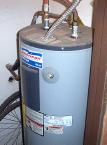 As I pulled into my neighborhood yesterday, one of the neighbors flagged me down to look at his water heater. It was belching water from the tank and so I helped him to turn it off and drain it. But it started me thinking about how we (myself included) neglect the maintenance on these things, and how the anode rod helps it to stay alive. Water heater repair is so fun.
As I pulled into my neighborhood yesterday, one of the neighbors flagged me down to look at his water heater. It was belching water from the tank and so I helped him to turn it off and drain it. But it started me thinking about how we (myself included) neglect the maintenance on these things, and how the anode rod helps it to stay alive. Water heater repair is so fun.
A water heater anode rod is a "sacrificial" rod that corrodes away, sparing the tank the same fate. Although your water heater's tank is glass-lined, there are bare metal areas such as seams and fitting penetrations that are susceptible to corrosion.
Your tank's main defense is the anode rod. In fact, would you like to take a wild guess as to what manufacturers do to increase the warranty from 6 years to 12 years, for example? Among other things, they add a second anode rod.
An anode rod is made from magnesium, aluminum or zinc, wrapped around a steel-support wire. The rod is screwed into the top of the tank, but you may have to do some digging to find it.
It's a good idea to check the rod and replace it if it's damaged. Generally, if you can see 6 inches of the support wire, or if the rod is deeply pitted or split, replace it. You may get it out and discover that there isn't even a rod left. As long as a good amount of the anode remains, the tank should operate well.
The rod is attached either to a hex head or the hot water outlet nipple (called a combination anode). Look at the top of the tank and check for the hex head. If it can't be easily spotted, it may be hidden under a plastic plug or insulation, or under the metal top of the heater. I wouldn't recommend removing the top sheet metal cover as some of these are "foamed" into place with expanding insulation.
Before you start playing with the anode rod, turn off both the heater and the water supply. Open the nearest hot water faucet to relieve the pressure, or drain some water out of the tank from the drain valve.
Inspect the top of the heater for the hex head. If you can't find one, you probably have a combination anode. Disconnect the flex pipe to the hot water nipple.
You will need something stiff and thin like a coat hangar or other piece of wire. Shove it down the hot water outlet nipple. If the wire stops after about 6 inches, you have a combination anode.
Removing the anode is as simple as unscrewing it. Don't think it will be that easy, though. If you water heater is not aging gracefully, you may need some brute force to bully the anode into coming loose.
Once you unscrew the anode, you may have another problem: the overhead clearance may not provide enough room to pull the anode out. You will have to either drain the water heater so you can lean it far enough to pull out the anode rod, or you can bend the rod and pull it out. This means you will have to bend the new rod to get it in (although some rods are made in flexible sections). Bend it in the middle just enough to gain clearance into the hole. Then you can straighten it against the rim of the hole and screw it in.
If you have a hex head-type rod, you can always add a combination anode for more protection. Just wrap the threads with Teflon tape, drop it in the hole, and screw it in. You just may add a few years of life to the water heater.